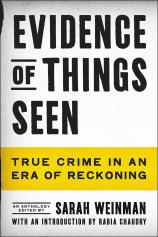Evidence of Things Seen: True Crime in an Era of Reckoning
Review
Evidence of Things Seen: True Crime in an Era of Reckoning
True crime has fascinated us for a long time, though perhaps we are seeing a heyday. Every week there are countless podcast episodes, books, television dramas and documentaries, and in-depth long-form essays. This is entertainment based on the pain, loss and suffering of strangers, curiosity about the depravity of the perpetrators, and horror that some survive and many do not. What are the responsibilities of the creators of these media tales? What does the consumption of true crime say about the audience? Whose voices are lost or vilified? Why are so many drawn to the genre?
In a new anthology edited by Sarah Weinman, these questions are confronted, turned over and over, and some compelling answers (and more important questions) are posited. EVIDENCE OF THINGS SEEN offers 14 previously published pieces from diverse authors, all wrestling with true crime as a genre and the real people who inhabit the stories.
"Fans of true crime will rethink some of their beliefs and choices. Those skeptical of the genre will find much that will resonate about culture, the legal system and the media beyond the popular podcasts and the latest sensational news bite."
The collection opens with an Introduction by Rabia Chaudry, who outlines some of the concerns and criticisms about the genre. The book’s selections, she suggests, are “evidence of the true crime genre’s potential to do good, to deliver justice in both large and small measures, by offering a small window into stories we’ve never heard before, from people society never thought mattered before.” This optimistic perspective is shared by many of the writers here, even when they have been shown that the impact that truthful storytelling can have is sometimes not enough to result in justice.
All of the book’s selections are well written, fascinating, deeply researched and interesting. Many are frustrating as well, as the writers highlight the ways in which true crime can overlook key elements and silence critical voices. Wesley Lowery writes of the dreadfully slow wheels of justice as a criminal investigation into a horrific murder is thwarted by the investigators themselves and the reality of racism in the U.S. The killing of Toyin Salau, the subject of a piece by Samantha Schuyler, and the crisis of missing Indigenous women as analyzed by Brandi Morin each highlight how race, as well as gender, negatively impacts outcomes of missing person and murder investigations. May Jeong’s look at the 2021 Atlanta spa shootings addresses race and gender, in addition to issues of immigration. Justine van der Leun’s essay flips this script, discussing incarcerated women, and Michael Hobbes’ contribution takes on white-collar crime.
The book’s second section shifts perspective with an essay by Amanda Knox asking “Who Owns Amanda Knox?” By contrast, Diana Moskovitz “revisits” true crime writer Edna Buchanan, illustrating how personal bias and ignorance has had ripple effects in the field of crime reporting. The rise of true crime junkies and amateur social media sleuths is explored by RF Jurjevics, and the kinds of celebrity that cops and detectives can enjoy is the subject of Lara Bazelon’s work.
The third section challenges readers in important and even unexpected ways. Amelia Schonbek writes about a program where victims and perpetrators of domestic violence meet in attempts at Restorative Justice. Keri Blakinger documents prisoner-run radio stations that offer some solace and community to incarcerated men. With “To the Son of the Victim,” Sophie Haigney imagines sharing her feelings, frustrations, condolences and apologies to the son of a couple murdered in their own home who she tried to interview as part of her work.
The book’s final piece is “Three Bodies in Texas” by Mallika Rao. In it, many of the complex and complicated themes and critiques of true crime as a sort of voyeuristic genre are examined with both a critical eye and a tenderness. Rao writes about an Indian immigrant accused of murdering her young son and the ways in which her culture, religion and identity were misunderstood. This is a story with no clear answers or satisfying resolution. It is heartbreakingly human and utterly exasperating. Rao does excellent work.
Fans of true crime will rethink some of their beliefs and choices. Those skeptical of the genre will find much that will resonate about culture, the legal system and the media beyond the popular podcasts and the latest sensational news bite.
Reviewed by Sarah Rachel Egelman on July 15, 2023
Evidence of Things Seen: True Crime in an Era of Reckoning
- Publication Date: July 4, 2023
- Genres: Nonfiction, Social Sciences, True Crime
- Paperback: 304 pages
- Publisher: Ecco
- ISBN-10: 0063233924
- ISBN-13: 9780063233928










